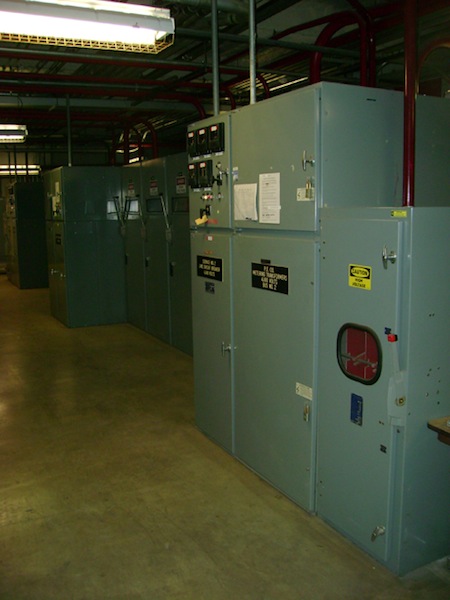Fault contributions of all parallel sources must be considered only for systems designed for continuous parallel operation.

There is some question as to the proper way to perform short-circuit analysis of systems that use closed-transition equipment. This article explores the rationale that it is not necessary to count the contribution of parallel sources to a fault if they are not designed to be operated in parallel. Where systems are designed for continuous parallel operation, the fault contributions of all parallel sources must be considered.
Closed-transition equipment
Closed-transition equipment (switchgear and automatic transfer switches) uses a make-before-break operating sequence to maintain uninterrupted power to essential loads throughout a transfer between live sources (see Figure 1). The importance of this is tied to the requirement to operate the transfer equipment periodically to comply with mandatory testing requirements, with the desire to avoid causing a disruption to electrical loads. Typically, the use of closed-transition equipment is limited to critical services where momentary interruptions during transfer testing cannot be tolerated. Hospitals, laboratories, and data centers are among the facility occupancies that often consider using closed transition in their automatic transfer switches, and for their main and/or substation switchgear.
Where closed-transition switchgear is used, short-term paralleling of two separate utility services occurs (see Figure 2). These services may originate from different sources within the utility grid. In these cases, coordination with the servicing utility and their engineering requirements is crucial to the success of the project. The serving utility normally requires that the transition be automatically supervised by synchronism-check relays, and that breaker interlocking controls are provided to limit the time duration of the parallel operation (100 msec—or 6 cycles—is a typical requirement, but it does vary from utility to utility). There are some utilities that do not allow their services to be paralleled, allowing only open-transition switchgear.
More common is the use of closed-transition automatic transfer switches. These switches also have a make-before-break sequence that allows the emergency source (typically one or more generators) to be operated in parallel with utility power for a short period of time (again, typically 100 msec) during transfers to and from generator power, where a stable utility source is present (see Figure 3). The use of closed-transition switches is especially popular in hospitals where generator and transfer switch testing can be performed without interruption to hospital activities if closed-transition equipment is used.
Effects on available short-circuit current
Many engineers are hesitant to use closed-transition equipment. This is because of the understanding that closed-transition adds size and cost to the project due to the need for increased fault-duty ratings. This engineering opinion is based on a common interpretation of the National Electrical Code (NEC)—specifically Articles 110.9 and 705.16 of the 2011 edition, which state:
110.9 Interrupting Rating. Equipment intended to interrupt current at fault levels shall have an interrupting rating not less than the nominal circuit voltage and the current that is available at the line terminals of the equipment.
705.16 Interrupting and Short Circuit Current Rating. Consideration shall be given to the contribution of fault currents from all interconnected power sources for the interrupting and short-circuit current ratings of equipment on interactive systems.
Taken at face value, these references seem to imply that the equipment specified—whether closed-transition switchgear or closed transition transfer switches and all of the equipment located downstream of these closed-transition devices—should be rated to interrupt the full available fault current of all utility and/or generator sources that may be connected during a closed-transition switching procedure. However, digging deeper reveals a picture that is not as clear cut.
In reviewing the NEC Handbook, Articles 110.9 and 110.10 are a matched pair of requirements. The Code Commentary for Article 110.10 states that “Literature on how to calculate short-circuit currents at each point in any distribution system generally can be obtained by contacting the manufacturers of overcurrent protective devices or by referring to IEEE 141-1993 (R1999): IEEE Recommended Practice for Electrical Power Distribution for Industrial Plants (Red Book).” Furthermore, the Code Commentary for Article 705.1 states that “Article 705 sets forth basic safety requirements for the installation of generators and other types of power production sources that are interconnected and operate in parallel as distributed generation.” Clearly, the use of closed-transition equipment does not equate to distributed generation.
The NEC Code Making Panel reviewed proposed changes to the wording of Article 110.9 in 2002 and again in 2005 to specifically allow the short-circuit rating to be exceeded in cases of a momentary closed transition. Both proposals were defeated. However, it is instructive to review the statement of the Code Making Panel in its rejection of the 2002 proposal:
Complex systems design criteria such as closed transition are inappropriate for specific inclusion in the NEC. Existing sections, such as 90-4 may be an appropriate avenue to deal with such issues.
Therefore, the NEC has specifically taken no position on the proper way to conduct a short-circuit study, but merely is stating that the results of the study will influence the selection of equipment with regard to short-circuit withstand and interrupting ratings.
Although the NEC commentary invokes IEEE 141 as an appropriate standard for the performance of a short-circuit study, that standard is silent on the issue of how to handle closed-transition between sources, as is IEEE 242-2001: IEEE Recommended Practice for Protection and Coordination of Industrial and Commercial Power Systems and IEEE 399-1997: IEEE Recommended Practice for Industrial and Commercial Power Systems Analysis. In fact, the only standard that actually addresses the issue directly is IEEE 666-1991 (R2007): IEEE Design Guide for Electric Power Service Systems for Generating Stations. In this standard, Part 4.6.1 states that “The major concern when paralleling both sources is fault current, which will be larger than that calculated for a single source. However, it is acceptable practice to design for the single-source condition if the duration of parallel operation is short.” Although this paragraph is specifically for manual transfer schemes, Part 4.6.2 regarding automatic transfers does incorporate Part 4.6.1.
While not directly applicable to facilities other than generating stations, IEEE 666 is the only standard that directly addresses the issue of closed transition versus fault current and, as such, is the most appropriate standard to apply in the design of closed-transition systems. Based on this, it is a reasonable practice to ignore the contribution of parallel sources in properly supervised closed-transition schemes when the following design considerations are included.
Design considerations
When designing a closed-transition system, it is imperative that the system be designed with interlocks that prevent the inadvertent and indefinite paralleling of sources. The following design rules should be used when designing closed-transition systems:
1. Closed-transition switchgear should be designed such that manual transfers are manually initiated and automatically interlocked. This prevents utility sources from being paralleled for an excessive amount of time. This transition should take place in the range of 100 msec, depending on specific utility requirements.
2. Closed-transition switchgear should be designed with a nondefeatable safety-circuit timing relay, which will cause source disconnection within a predetermined time if the sources are manually paralleled, or the closed-transition interlocking scheme fails to perform. For example, a timing relay that opens the tie breaker if both utility mains are closed for 10 sec would serve this function.
3. Where closed-transition automatic transfer switches are specified, a shunt-trip circuit breaker on the emergency feeder could be specified to force the emergency feeder to open in the case of a failed-closed transition.
4. All of the functions noted in 1-3 above should be alarmed and annunciated.
Due to their nature and required supervision capabilities, closed-transition systems are somewhat more expensive than open-transition systems. However, when properly designed, the cost of these systems need not be prohibitive.
Summary
Based on a review of applicable codes and standards, there is no need to consider both sources of fault current when sizing equipment for closed-transition transfer schemes. However, when making this determination, it is important that the proper electrical interlocking or other supervision techniques are used to ensure that the system cannot be inadvertently placed into a maintained parallel state, which would require that the equipment be sized for the combined parallel sources. This will assure a safe, cost-effective installation that complies with NEC requirements, and is consistent with IEEE guidelines.
Benjamin O. Medich is a senior associate and senior electrical engineer at Ballinger. He has been designing electrical systems for hospitals, labs, and universities for more than 16 years, and has published articles on arc flash analysis and selective coordination.



